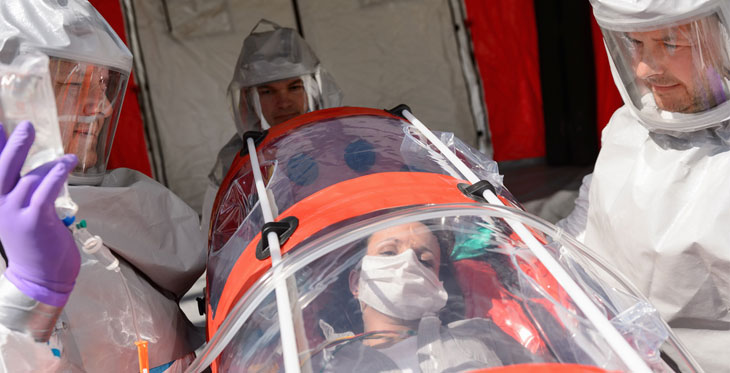The boy's eyes are captivated by the voice of the woman in the white starched coat. She seems to be speaking directly to them from the television screen. His mother's face relaxes for the first time in weeks as she holds him and repeats in a soft voice as if to convince herself, "The quarantine is over."
***
Although not a current reality, medicine has entered the digital age, and this scene may be tomorrow's reality.
Telecommunication technologies impact almost all medical specialties with tools ranging from "full-service" telemedicine systems that allow a near-complete physical exam to be conducted at a distance, to tele-home health units, to self-monitoring devices partnered with mobile technologies.
Digital tools may serve as critical missing puzzle pieces towards the primary goal of Ebola preparedness efforts: control of disease transmission.
The Disease and Transmission
Ebola is a disease transmitted through close contact. Those at greatest risk for disease transmission are friends, families, and health care workers. Keys to control of disease transmission are: early identification and monitoring of contacts, and early identification and treatment of those with the disease.
There’s many ways digital tools could impact the process of diagnosing and treating a disease like Ebola. One example would be an Ebola hotline to serve as the point of entry for care.
Triaging through an Ebola Hotline
A single national Ebola hotline number could connect an at-risk patient to a trained Ebola screener who can assess the patient’s likelihood of exposure, clinical acuity, and need for care. The hotline number could produce an audio or audio/video connection depending on how the at-risk patient chooses to access the service. A screener would then follow an evidence-based decision-tree to conduct the assessment. The screening process limits exposures while facilitating care for the person potentially exposed to Ebola.
Triage outcomes would include:
- No probability of exposure: triage to timely education regarding Ebola risk exposure immediately after contact with the screener.
- Low probability of exposure: triage to required follow-up after public health assessments of the possible contact.
- High probability of exposure without symptoms, with internet access, and with access to an online communication device: triage to virtual follow-up—patient receives a link to a secure video connection through which, at least, daily video nurse assessments including temperature monitoring, as described below, take place. Ongoing public health assessment to confirm the exposure.
- High probability of exposure without symptoms, with internet access, and without access to an online communication device: triage to virtual follow-up—patient receives an internet enabled tablet for the video nurse assessment and a Bluetooth enabled digital thermometer for temperature monitoring via a commercial same-day mailing service. Ongoing public health assessment to confirm the exposure.
Caring for High Risk Patients Remotely
All patients with a high probability of exposure to the virus and who are without symptoms would receive a Bluetooth enabled digital thermometer for temperature monitoring via a commercial same-day mailing service. The uniformity of the Bluetooth enabled digital thermometer is intended to assure accurate temperature assessments.
These types of virtual nurse-based assessments in accord with best practice guidelines, would allow the patient to stay in her/his home community and environment while receiving appropriate surveillance for early intervention and minimizing community risk.
Patients with a high probability of exposure or known exposure with acute symptoms of Ebola, i.e. fever, nausea, vomiting and dehydration, need urgent supportive and therapeutic care that minimizes exposure to the virus.
Safe Transfers via Video Enabled Ambulance
Once identified as an individual who needs clinical care, safe transfer to the treatment center could take place via a fully interactive video-enabled ambulance staffed by trained personnel who are equipped with the appropriate safeguards to minimize risk. The staff could also be virtually connected to Ebola treatment experts en route to the treatment center.
Minimizing Risk in Patient Rooms
At the designated treatment center, patient rooms would be set up along the e-ICU model with the goal of facilitating care while minimizing risk. Rooms would be equipped with:
- Ceiling cameras controlled by both the local and the distant site
- Telemedicine physical exam attachments
- Bidirectional voice activated microphones
- Wearable technologies that facilitate continuous vital sign monitoring
- Seamless access to the patient’s electronic record including laboratory and radiographic findings
Akin to the e-ICU model, the patient’s care may be supported virtually as feasible. Centralized experts could provide 24-hour regional care for Ebola by means of distance monitoring tools, centrally controlled high-definition digital cameras, and electronic attachments that allow for physical exam assessments.
These same telecommunications tools could be utilized to keep the patient connected to her/his family and friends during the treatment process, thus reducing the sense of isolation and depression.
Managing Ebola Care with Telemedicine
Maximizing the use of digital tools in the care of patients with Ebola exposure or infection may enable patients to stay closer to home and minimize the risk of disease transmission brought on by need to travel for care. Telemedicine may also minimize health professional exposure by delivering care virtually.
Telemedicine can be an effective tool to prevent Ebola disease transmission, control spread of the disease, and facilitate access to timely and appropriate clinical care.

